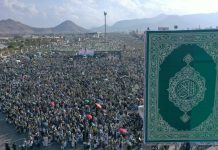The significant challenges imposed by the Yemeni Armed Forces’ military operations in the Red Sea over the past year have prompted the US administration to begin updating its warships and destroyers’ systems to address critical vulnerabilities exposed during these naval battles.
According to the US Navy’s systems command website, the Surface Combatant Task Unit Program Office upgraded the (C-UAS) drone defense system aboard the USS Indianapolis, a Freedom-class warship. The site explained that recent events in the US Fifth Fleet’s area of responsibility highlight the importance of equipping warships with modern (C-UAS) systems to control emerging threats. The update includes the integration of radar-guided (Hellfire) missiles to counter these threats.
A report by Task & Purpose, a US Navy affairs site, revealed that the USS Indianapolis was stationed in the Red Sea last fall during a mission that lasted several months, and in September 2024, it, along with two other destroyers, came under Yemeni attack in the Red Sea.
This upgrade is driven by a search for more cost-effective alternatives to expensive munitions previously used by the US Navy in the Red Sea against the Yemeni forces. The Hellfire missile costs approximately $200,000, significantly cheaper than the RIM missiles aboard the ship, which cost over $1 million each, or the even more expensive SM-2, SM-3, and SM-6 missiles that have been used in hundreds of instances in the Red Sea.
The War Zone, a US military site, reported that last year, the US Navy conducted an intensive training program to enable Freedom-class coastal combat ships equipped with radar-guided Hellfire missiles to use these weapons against unmanned aerial systems (drones). This came in direct response to concerns about Yemeni drone threats to US warships operating in and around the Red Sea.
The USS Indianapolis was the first ship to receive this upgrade. It’s unclear how many other Freedom-class ships are set to receive similar upgrades or whether this capability will be extended to other ship classes.
The War Zone also noted that Lockheed Martin recently displayed a model of an Arleigh Burke-class destroyer equipped with two sets of launchers for Hellfire missiles, indicating that destroyers might also receive this update.
Initially, the main purpose of this system was to provide these ships with additional capabilities to counter swarms of small, manned or unmanned boats, a real threat, especially from Yemen, which has pioneered the use of unmanned suicide boats laden with explosives.
In related news, a report by the US Naval Institute revealed that the US Navy has started updating systems on some of its destroyers, with the USS Sterett being the first to receive all updates under the Destroyer Modernization 2.0 program, including new electronic warfare and radar systems, as well as combat system upgrades. Other destroyers, including the USS Pinckney, USS James E. Williams, USS Chung Hoon, and USS Halsey, are set to undergo this project in two phases, with the total cost of the upgrade program reaching $17 billion.
Captain Tim Moore, a naval officer, was quoted stating that these ships, originally built with the SPY-1 radar and the Aegis combat system, will now have the old radar replaced with the new SPY-6 system, alongside other significant upgrades.
Yemen has declared open support for Palestine’s struggle against the Israeli occupation since the regime launched a devastating war on Gaza on October 7, 2023, after the territory’s Palestinian resistance movements carried out Operation Al-Aqsa Storm against the occupying entity.
The Yemeni Armed Forces have achieved significant victories against the naval forces of the US, the UK, and Israel. These operations led to the effective shutdown of the Port of Eilat, also known as Um Rashrash, and forced the US aircraft carriers to retreat from the Red Sea. The Yemeni forces also sank or damaged dozens of Israeli-linked ships.
These achievements have surprised many observers, as Yemen was not previously regarded as a significant naval power. The Yemeni Armed Forces have vowed to continue their operations as long as the Israeli regime maintains its war and siege against Palestinian territories.




















